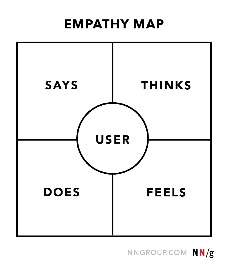What is an Empathy Map to a Persona?
Reading Time 4 mins
When creating new services or products you can ensure you genuinely meet the end-user's needs with Personas, but another informative method is Empathy Maps that can build into personas. Personas help you create detailed profiles of your target users, giving you a deeper understanding of who they are, their goals, and what motivates them. On the other hand, empathy maps dive into the specific experiences and emotions of individual users, helping you empathize with their joys, frustrations, and needs. By using these methods, you can go beyond assumptions and truly connect with your users, ensuring that your designs and services are user-centered and deliver meaningful experiences that delight users and customers. In both cases they externalize knowledge about users in order to 1) create a shared understanding of user needs, and 2) aid in business decision making.
The key differences between empathy mapping and personas lie in their focus and level of detail. Here are the explicit differences:
- Focus: Empathy mapping focuses on understanding the emotions, thoughts, behaviors, and needs of a non-identified individual user during a specific experience or journey. It delves into the user's perspective and aims to uncover deeper insights into their emotional motivations and pain points. Personas, on the other hand, is a fictional characterization of many users that can represent multiple broad user groups and provide a holistic view of their story, specific characteristics, frustrations, goals, behaviors, and needs.
- Level of Detail: Empathy maps capture specific details and nuances of an individual user's experience, often in a visual format. They highlight specific observations, quotes, and key moments to deepen empathy and understanding. Personas, in contrast, provide a visual representation of user segments. They aggregate data and insights from many users to create a categorized composite profile that helps guide business decision-making and design efforts.
The process of using these methods typically involves a collaborative visualization following these outlined steps.
| Empathy Mapping: | Personas: |
|---|---|
|
|
By understanding these differences and following the respective processes, teams can gain valuable insights and create user-centered solutions that meet the needs of individual users and broader user segments alike.
Resources:
Interaction Design Foundation: https://public-media.interaction-design.org/pdf/Empathy-Map.pdf
Nielsen Norman Group: https://www.nngroup.com/articles/empathy-mapping/
HCD Methods- Empathy Maps: Empathy Maps
HCD Methods-Personas: Personas
HOWARD MONTGOMERY
Howard is a practicing agnostic Human-Centered Design Thinking expert who thrives across the consumer experience continuum of products, services, digital, brand, strategy, and environments. He has led, collaborated and consulted with multiple Fortune 100 companies: Ford Motor, Unilever, BMW, The Home Depot, Steelcase, P&G and LG Electronics across diverse business sectors; building products, automotive, consumer, food and healthcare. He holds 48 International Patents and has been the recipient of over 25 international awards including IDEA Awards, iF Award and Good Design Award, and multiple publications of his work. He has taught at several schools in the USA and UK. He holds a bachelor’s degree with honors from Kingston University, London, UK and master’s degree from Cranbrook Academy of Art, Bloomfield Hills, USA, both in Design.
 ISG Playbook
ISG Playbook APIs
APIs
